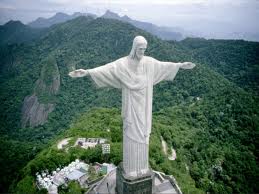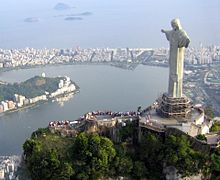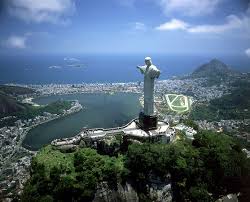The 125-foot statue (including pedestal) is an art deco style design by Heitor da Silva Costa, carved by French sculptor Paul Landowski. The statue took five years to construct with the pedestal and chapel being ready to accommodate 150 people as of October 1931.The idea of erecting a large statue atop Corcovado was first suggested in the mid-1850s, when Catholic priest Pedro Maria Boss requested financing from princes Isabel to build a large religious monument. Princess Isabel did not think much of the idea and it was dismissed in 1889, when Brazil became a republic with laws mandating the seperation of churh . The second proposal for a Landmark statue on the mountain was made in 1920 by the Catholic Circle of Rio.
The group organized an event called Semana do Monumento (“Monument Week”) to attract donations and collect signatures to support the building of the statue. The donations came mostly from Brazilian Catholic. The designs considered for the “Statue of the Christ” included a representation of thechristan cross, a statue of Jesus with aglobe in his hands, and a pedestal symbolizing the world. The statue of Christ the Redeemer with open arms, a symbol of peace, was chosen.
The statue was struck by lightning during a violent electrical storm on Sunday, February 10, 2008, and suffered some damage on the fingers, head and eyebrows. A restoration effort was put in place by the Rio de Janeiro state government to replace some of the outer soapstone layers and repair the lightning rods installed on the statue. It was again damaged by lightning on Thursday, January 17, 2014, where a finger on the right hand was dislodged.
More work on the statue and its environs was conducted in 2003 and early 2010. In 2003, a set of escalators, walkways, and elevators were installed to facilitate access to the platform surrounding the statue. The four-month restoration in 2010, carried out by mining company Vale in partnership with the Archdiocese,focused on the statue itself. The statue’s internal structure was renovated and its soapstone mosaic covering was restored by removing a crust of fungi and other microorganisms and repairing small cracks. The lightning rods located in the statue’s head and arms were also repaired, and new lighting fixtures were installed at the foot of the statue.
A symbol of Brazilian Christianity, the statue has become an icon for Rio de Janeiro and Brazil.[2] It is made of reinforced concrete and soapstone, and was constructed between 1922 and 1931





